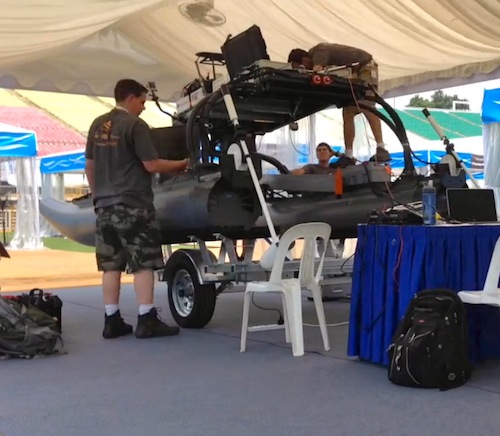Featured Stories | November 3, 2014
RobotX, an international win for MIT marine vehicle designers
By Genevieve Wanucha
This week a team featuring multiple Computer Science and Artificial Intelligence Laboratory (CSAIL) researchers took home the $24,000 grand prize in an international competition centered on autonomous underwater vehicles (AUVs).
Members of CSAIL’s Marine Robotics Group joined more than 20 other researchers from MIT and Olin College as one of 15 teams competing in the Maritime RobotX Challenge, which took place Oct. 20-26 in Marina Bay, Singapore. The goal of the challenge was to stimulate innovation in unmanned ocean vehicle technology, which holds key applications in such areas as search-and-rescue, shipping security, environmental monitoring, and marine science.

Each research group spent the past year developing sensors, computers, and software for the challenge’s template vehicle, the “WAM-V,” a self-driving propeller-motored boat that resembles an oversized jet-ski. “We took a lot of the original sensors from those used in the MIT DARPA Grand Challenge, and we augmented it with new sensors including our new Velodyne HDL-32E real-time 3D LiDAR sensor,” says Nick Rypkema, MIT/WHOI Joint Program student. (This Velodyne technology uses 32 laser to enable underwater navigation and 3D mapping of the environment.)
For the competition, teams deployed their boats on a special course of tasks that tested motion planning, control, and autonomy, including avoidance and detection of obstacles, identifying targets, and searching underwater for acoustic sources. Learn about the boats and the MIT-Olin team that outdid all others in these videos:
MEET THE BOATS
A look inside the AUVSI Foundation’s Maritime RobotX Challenge
Now, the MIT-Olin vehicle will be transferred to MIT’s Sea Grant Laboratory, where researchers will deploy an remotely operated vehicle (ROV) off the bottom to explore and monitor underwater environments for a variety of ongoing projects.
CSAIL members of the team include research scientist Mike Benjamin (autonomy), postdoctoral associate Liam Paull and graduate student Nick Rypkema (vision/lidar), and principal investigator John Leonard (safety/sensing). Also participating were multiple members of the Department of Mechanical Engineering.
The challenge was organized by Northrop Grumman, the Association for Unmanned Vehicle Systems International Foundation, the Office of Naval Research and Singapore’s Ministry of Defense.





